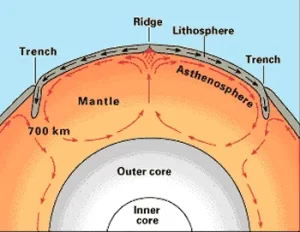Convection Current Theory by Arthur Holmes: UPSC Elaborated Notes
Building on Continental Drift

The Continental Drift Theory, proposed by Alfred Wegener, provided a compelling picture of continents moving across the Earth’s surface. However, it lacked a convincing explanation for the driving force behind this movement. The Convection Current Theory, introduced by Arthur Holmes in the 1930s, addressed this limitation by proposing a mechanism for continental drift.
The Inner Workings: The Mantle and Asthenosphere
- The Earth’s interior is layered, with the mantle lying between the crust (the outermost layer) and the core.
- The mantle is a solid rock layer, but its properties change with depth. The upper mantle, called the asthenosphere (meaning weak sphere), experiences high pressure and temperature, causing it to behave like a plastic solid. This means it can deform and flow very slowly over long geological timescales.
- Radioactive elements present throughout the mantle decay, releasing heat. This heat isn’t uniformly distributed, leading to variations in temperature within the mantle.
Birth of Convection Currents
- Due to temperature differences, hotter and less dense mantle material near the core tends to rise. Conversely, cooler and denser material near the surface sinks. This creates a continuous, circular motion within the mantle called convection currents. These currents move very slowly, typically at a rate of a few centimeters per year.
Impact on Tectonic Plates
- The Earth’s outermost rigid layer, broken into large slabs, is called the lithosphere. It consists of the crust and the uppermost part of the mantle. The lithosphere, in turn, is divided into several rigid tectonic plates.
- The slow-moving convection currents in the asthenosphere below the lithosphere aren’t strong enough to move the entire rigid lithosphere directly. However, they can drag the overlying tectonic plates along passively, causing them to move horizontally across the Earth’s surface.
Types of Plate Boundaries and Geological Consequences
- Divergent boundaries: As hot mantle rises at these zones, it creates a force that causes plates to spread apart. This allows for decompression melting, forming new oceanic crust (e.g., Mid-Atlantic Ridge). This explains seafloor spreading and the movement of continents away from each other, aligning with observations from Continental Drift Theory.
- Convergent boundaries: When convection currents push plates together, they collide and crumple, leading to mountain formation (e.g., the Himalayas formed due to the collision of the Indian and Eurasian plates).
- Transform boundaries: Plates can also slide past each other horizontally along transform boundaries. Friction at these boundaries creates stress, leading to earthquakes (e.g., San Andreas Fault).